HOLIDAY SALE—UP TO $50 OFF Y-DNA
Reveal the legacy only Y-DNA can tell.
Discover the story passed from father to son, trace your paternal line back through time and connect with your Y-DNA matches.
FROM $79USD
SAVE $40 (WAS $119)A test for genetic males, Y-DNA is used to help answer questions about relatedness on the paternal male line.
Y-37
(37 markers tested)
ONLY $79USD
SAVE $40 (WAS $119)
- Entry-level paternal line test
- Connect with distant paternal-line relatives
- Provides a basic, predicted haplogroup for migration insights
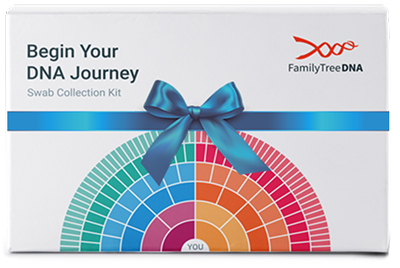
Y-111
(111 markers tested)
ONLY $199USD
SAVE $50 (WAS $249)
- Includes everything in Y-37
- Find closer matches within genealogical timeframes
- Great for surname studies and line-specific research

Big Y-700
(700+ STRs and 700K+ SNPs tested)
ONLY $399USD
SAVE $50 (WAS $449)- Includes everything in Y-37 & Y-111
- Discover your expanded migration path into recent centuries
- Explore deeper surname and family history connections
- Receive matches and data updates over time as science advances

WHO CAN USE?
Y-DNA is passed down from father to son
Genetic males can have their Y-DNA tested. Y-DNA testing can help you discover and verify your direct paternal ancestry by connecting you with other individuals who are descendants of a shared common patrilineal ancestor.



Find Your Perfect Y-DNA Test
Answer a few questions to get a personalized recommendation for which Y-DNA test best suits your research interests.
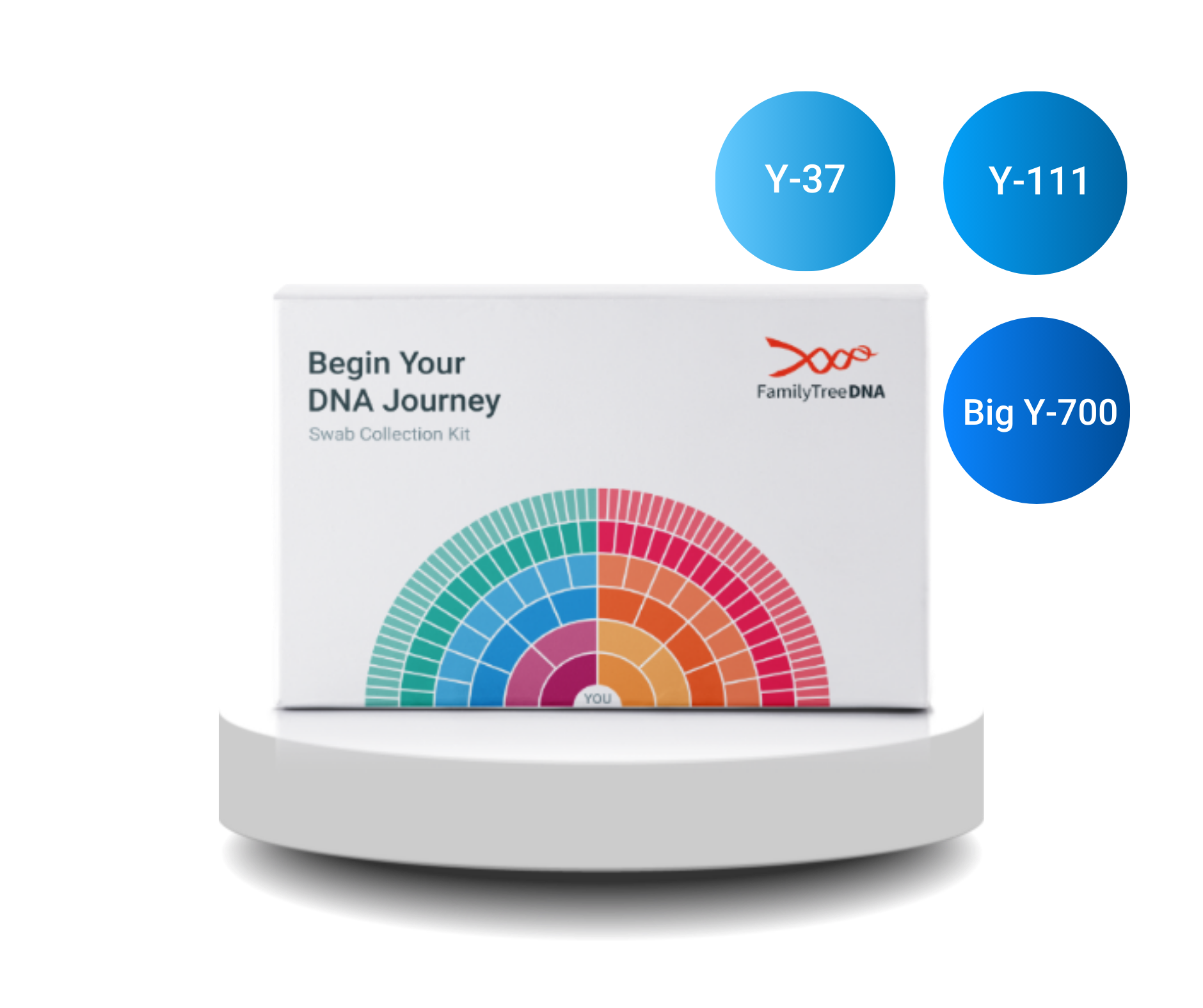
CONNECT WITH Y-DNA RELATIVES
Join the world’s largest database of Y-DNA testers
Your Y-DNA matches will share a common ancestor with you on your direct paternal line. That common ancestor can be recent (meaning within a generation or two) or more distant (living up to around 1,000 years ago). The tools and data gained through a Y-DNA test can help you learn more about your patrilineal family history.
- Connect with matches to discover your shared patrilineal ancestry.
- View and explore your Y-DNA matches’ Family Trees.
- Discover new patrilineal ancestors.
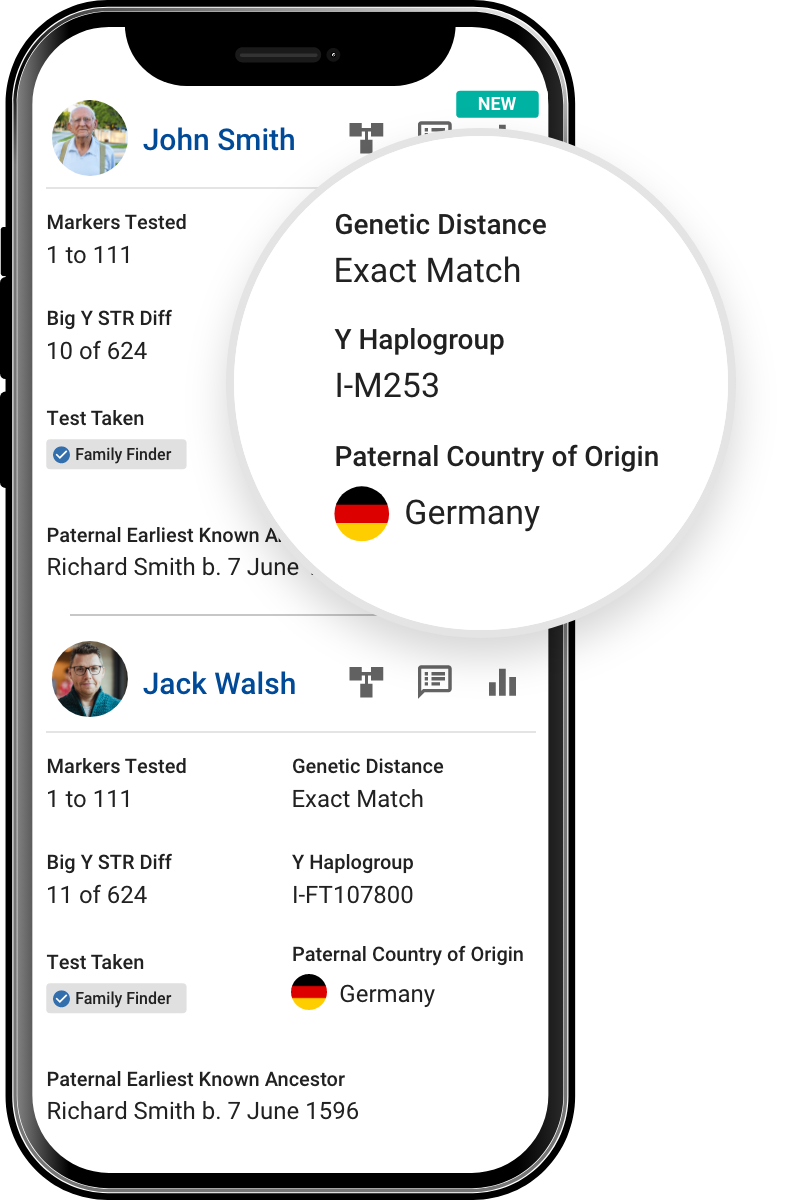
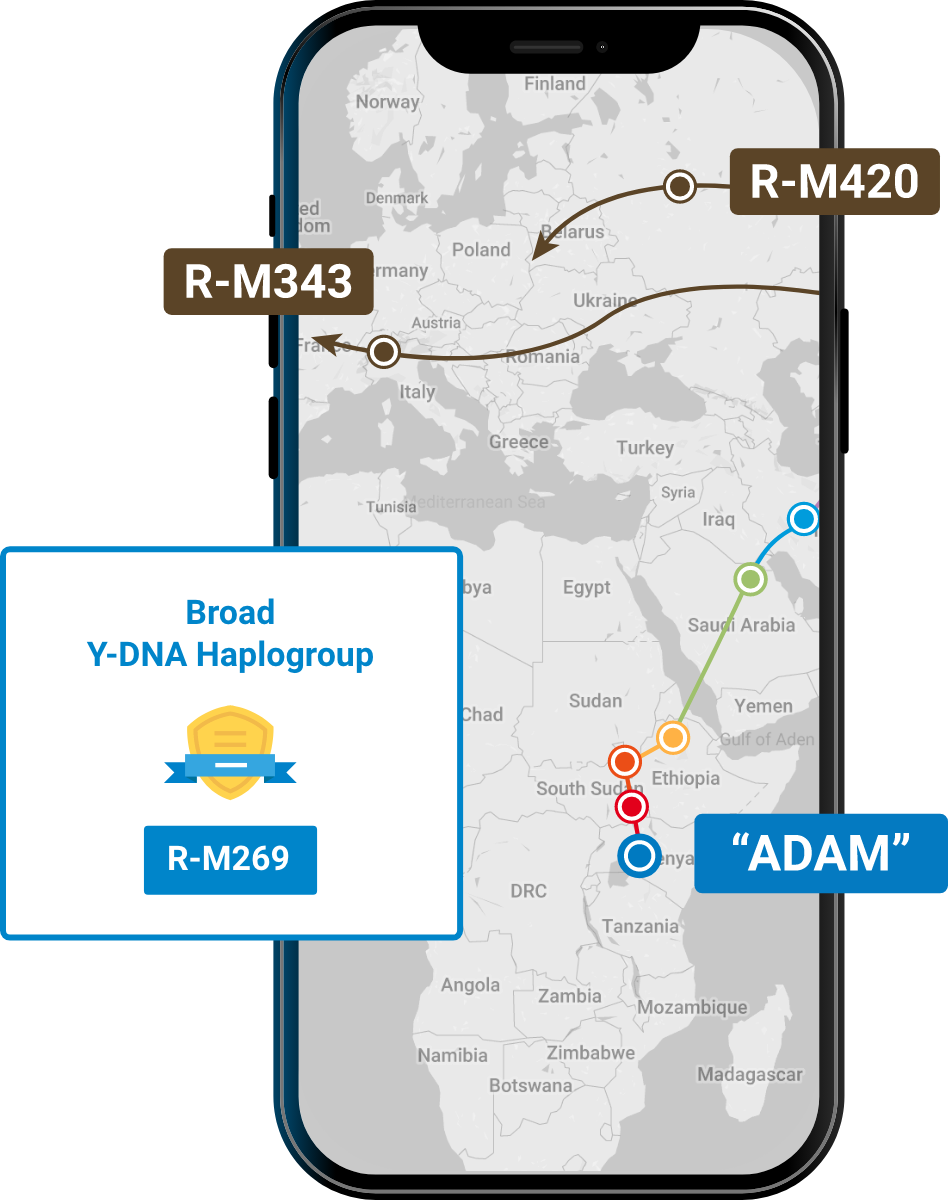
DISCOVER YOUR Y-DNA HAPLOGROUP
Follow the path of your direct male ancestors
Genetic males can use Y-DNA to determine where their direct paternal ancestors came from, their locations in historic times, and how they migrated throughout the world.
- Discover your patrilineal ancestors’ ancient migration path out of, or across, Africa.
- Find your placement on the world’s largest Y-DNA Haplotree.
Y-DNA FTDNATIP™ REPORT
Get estimates of how far back in time you and a match shared a common paternal ancestor
- Estimate how “close” your relationship is with a match.
- Guide your research to historical times and places.
- Confirm genealogical theories.
- As the number of markers increases (Y-37 to Y-111), we are able to predict time ranges with more precision.
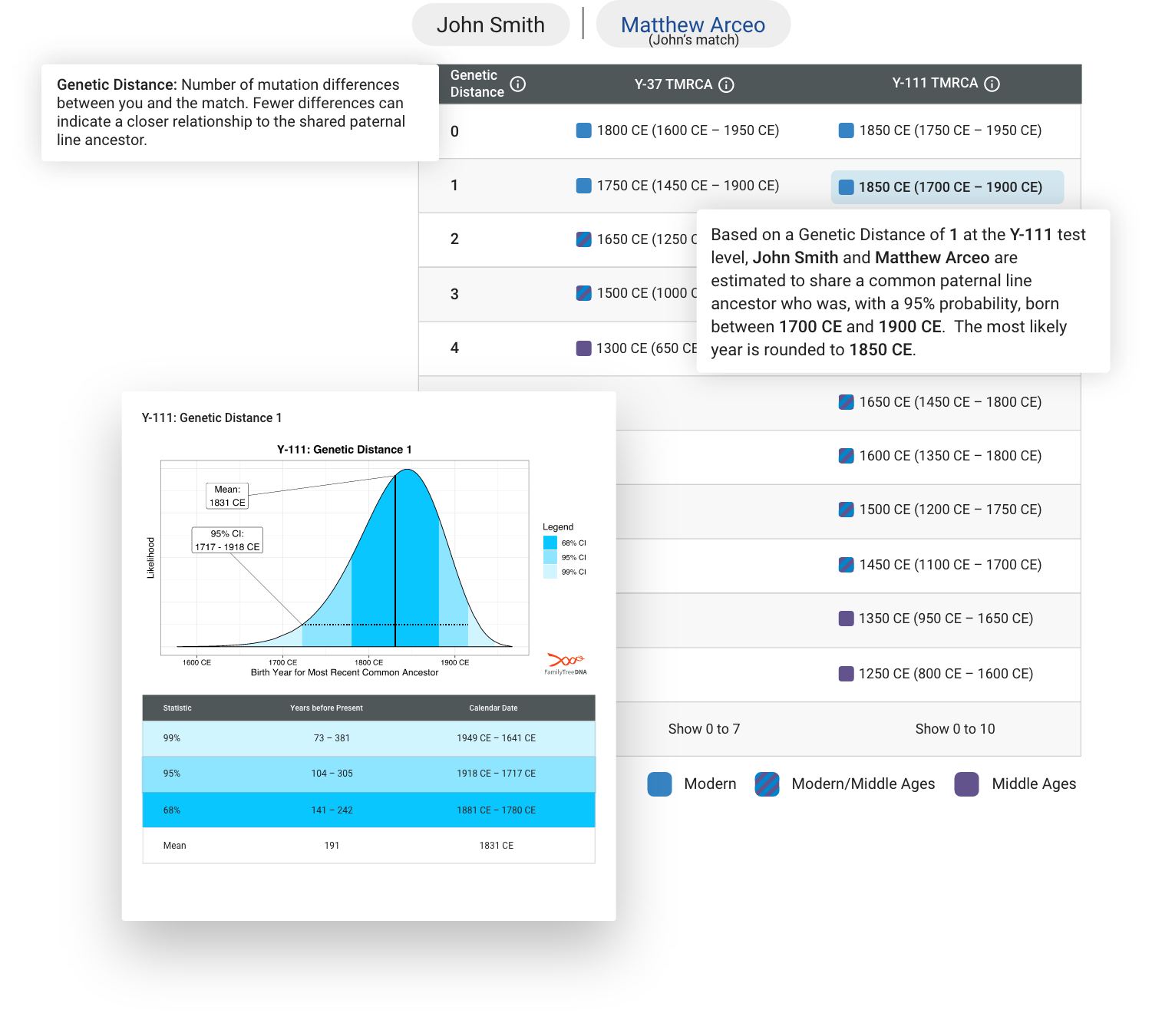
Access FamilyTreeDNA Discover™
New reports based on your confirmed Y-DNA haplogroup
GROUP PROJECTS
Y-DNA Group Projects
- Surname Projects: For people who have the same surname or who have similar variants of that surname.
- Y-DNA Geographical Projects: Look at Y-DNA testers within a specific region, whether it’s an entire country or narrowed to a specific county, to see the composed haplogroups and ancestral lineages of that area.
- Y-Haplogroup Projects: Range from main branch projects, such as R1b or J1, to their subclades/subgroups further down the haplotree. Y Haplogroup projects may focus on the big picture for that haplogroup or branch, or they may focus on specific lineages. These projects look at the origin of a haplogroup or subclade and its dispersion over time across geographic regions.


Your DNA sample is stored in our lab, so you can easily add-on or upgrade your testing level.
Y-DNA Tests
A test for genetic males, Y-DNA is used to help answer questions about relatedness on the paternal male line.
Real stories from real Y-DNA customers
Through Y-DNA testing, I successfully broke down a 30-year genealogical brick wall with the help of my YDNA matches. They assisted in identifying the origins of my surname back to 1595 in Scotland and the subsequent emigration of my branch to Ulster. FamilyTreeDNA’s role in this remarkable journey is immeasurable.
— Paul, Verified Y-DNA Tester
Have questions? We have answers.
Here are the most frequently asked questions about FamilyTreeDNA. If you have additional questions, feel free to visit our Help Center or reach out to our Customer Service team.
Which test should I buy?
If you are looking to begin Y-DNA testing, the Y-37 Marker test allows you to become familiar with Y-DNA results. The Y-111 test is the most beneficial for joining our free Group Projects or for those looking to confirm Y-chromosome matching between two living men. The Big Y-700 is for explorer users, it provides over 400K SNPs and additional STRs. If you’re looking to find your placement on the Y-DNA Haplotree, then the Big Y-700 is the test you will need to purchase.
Each of the Y-DNA levels we offer will test different amounts of the Y chromosome. The more of the Y chromosome that is tested, the more closely related we can tell if someone is to you.
Out of the three levels that we offer, the Y-37 tests the fewest STRs, and so through analysis of your matches, you can only know you share a common patrilineal ancestor within several hundred years for certain.
The Y-111 provides more STR results for a higher-resolution comparison and includes the Y-37 test, so through analysis of your matches you can determine a better timeframe of when your common patrilineal ancestor lived.
The Big Y-700 looks at everything that is genealogically relevant on the Y chromosome, so you’ll receive everything that you would with the Y-37 and the Y-111, plus additional results that allow us to provide more analysis and help you refine even further to determine the best timeframe for when your common patrilineal ancestor lived as well as find your best placement on the world’s largest Y-DNA haplotree.
What is Y-DNA?
Y-DNA is what we call the sex chromosome “Y” that is passed from a father to his sons only, women do not receive a Y chromosome. Testing the Y chromosome allows for investigation into a male’s paternal family line and can help identify surname lines, living relatives whose Y chromosome is similar to yours, and ancient migration routes your paternal ancestors may have taken.
What is a Haplogroup?
Every male individual who takes one of our Y-DNA tests will also receive their Y-DNA haplogroup. When humans left Africa tens of thousands of years ago, they departed in small groups that migrated into different parts of the world. Over many generations, each group developed distinct mutations allowing us to identify one from the other. We call these groups of mutations haplogroups, and they can tell us which migratory routes our paternal ancestors traveled.
What does SNP stand for?
Single nucleotide polymorphisms, frequently called SNPs (pronounced “snips”), are the most common type of genetic variations. Each SNP is a mutation or new branch on the tree. The number of SNPs on which people match within a database can be used to tell how closely related they are.
What is a Marker or STR?
A marker is what we test in our basic Y-DNA tests. These markers are also referred to as STRs (Short Tandem Repeats) which are a series of repeating nucleotides (A, T, G, C). For example: GACTACTACTACTGG – the STR consists of the three repeated CTA segments. Y-DNA tests look for matching markers or “STRs” between two men, if they match, which would indicate a genetic relationship.
Will I only match people who share the same surname as me?
Nearly 100% of Y-DNA testers are able to find a match that shares a common surname with them with some specific exceptions.
If your direct paternal line is from a society or culture that did not adopt surnames until recently or from a society that used patronymic surnames that changed every generation, you may see many surnames on your match list.
Many countries and regions did not officially adopt standard surnames as we think of them today until the 1700s, 1800s, and even the 1900s in some cases.
If your matches share a common ancestor with you before the time when surnames were established in your ancestral location, then you may have multiple different surnames on your match list.
There are various different cultural practices that may have existed prior to the standardization of surnames. A last name may have been based on an occupation, patronymics, or on a location where your ancestors lived. A last name may have been taken because your ancestors were part of a specific clan, even though not all men were directly related on the paternal line.
You may also have situations where a different surname than you expected shows up repeatedly in your matches list. This may be because of an undocumented name change or an out-of-wedlock birth somewhere in your direct paternal line.
This rarely means that through the test you discovered that you are adopted and that your birth father is not who you thought he was. The vast majority of the time, this is going to be a situation that is much further back in time.
Every now and then, there are no or very few testers in the database who share your direct paternal line. This is either because few people from your ancestral location or line have tested or because there are not many people available to test on your direct line in general.
The Y-DNA test results will typically provide you with fewer matches than a test like the Family Finder™. The Family Finder™ is looking at all of your ancestral lines. The Y-DNA is focusing on just one of those lines. If your direct paternal line does not have many descendants, or if it was decimated through an event such as the Holocaust or the Armenian Genocide, then you may have limited matches.
Your match list will typically grow over time. As more people test, more people will match you and be added to your list. We’ll send you a notification when this happens. There are many other historical and cultural reasons why you may not share the same surname with all of your Y-DNA matches. Joining surname, geographical, and the appropriate haplogroup Group Projects, as well as reaching out to your matches, can help you uncover your connections.